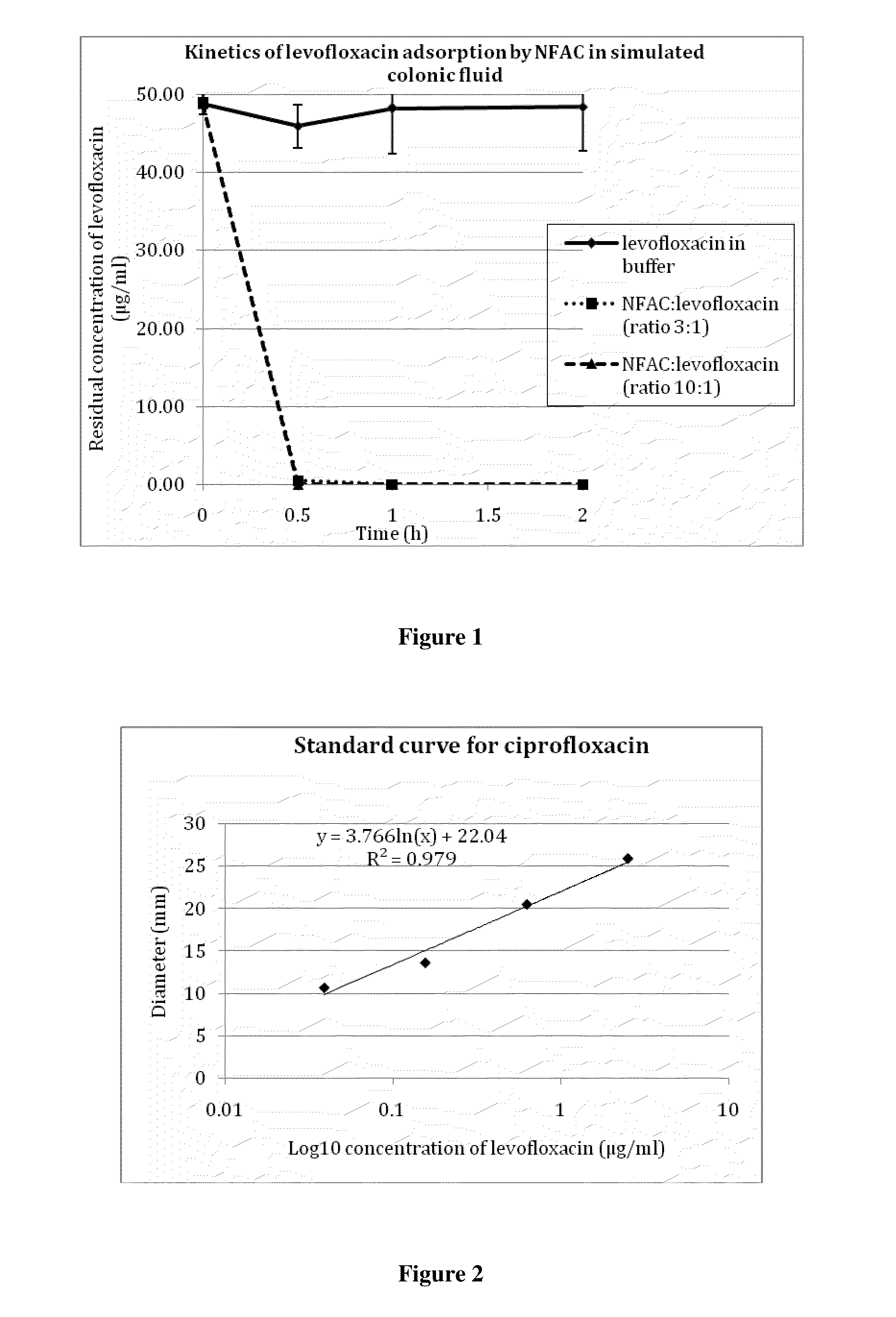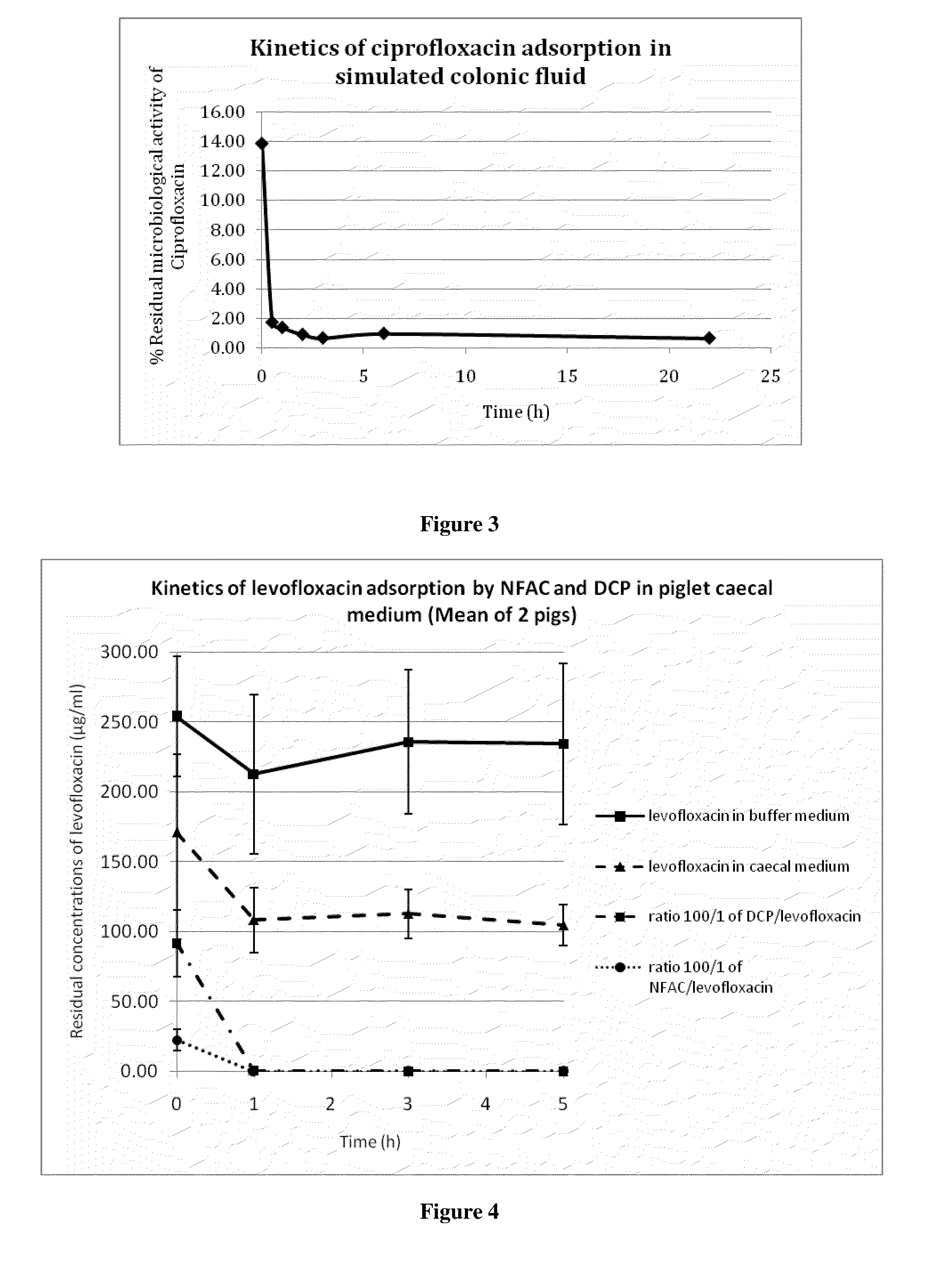Formulations for oral delivery of adsorbents in the gut
a technology of adsorbents and forms, which is applied in the field of forms for oral delivery of adsorbents in the gut, can solve the problems of complex further infections, difficult formulation of activated charcoal products, and difficult treatment of major outbreaks of infections with available antibiotics either in humans or in animals, so as to eliminate or reduce the side effects of pharmaceutical agents, and eliminate or reduce the side effects of antibiotic agents
- Summary
- Abstract
- Description
- Claims
- Application Information
AI Technical Summary
Benefits of technology
Problems solved by technology
Method used
Image
Examples
example 2
Microbiological Assay of Ciprofloxacin and Levofloxacin
[0209]The microbiological assay consists in measuring the biological activity of an antibiotic, i.e. its capacity to inhibit the growth of an indicator bacterial strain. To this end, agar plates were made with Difco medium 5, containing E. coli strain CIP 7624 as indicator strain. 20 μl samples containing the antibiotic to be measured were spotted onto paper discs applied directly onto the surface of the agar plates. After 18 h incubation at 37° C., the diameters of the zones around the paper discs where bacterial growth had been inhibited by the presence of the antibiotic were measured.
[0210]As shown in FIG. 2, there is a linear relationship between the logarithm of the concentration of the antibiotic solution (log10 μg / ml) and the diameter (mm) of growth inhibition. The assay was linear from 0.04 to 5 μg / ml ciprofloxacin.
[0211]When 20 μl of a suspension of non formulated charcoal was spotted onto the discs, no growth inhibitio...
example 3
Kinetics of Ciprofloxacin Adsorption by Activated Charcoal Measured by Microbiological Assay
[0213]A solution of ciprofloxacin (50 μg / ml) was incubated with 150 μg / ml activated charcoal in modified simulated colonic fluid (18.7 mM maleic acid, 84 mM NaCl, pH 6.0). Samples were withdrawn at various times, centrifugated, and the amount of ciprofloxacin remaining in the supernatant was measured by a microbiological assay as described in example 2. As shown in FIG. 3, the result was essentially the same as in the experiment described in example 1, where antibiotic concentrations were measured spectrophotometrically. Almost all of the antibiotic was adsorbed onto the charcoal within one hour. It is worthy to note that the sample marked as withdrawn at time zero in fact represented approximately one minute of contact between ciprofloxacin and the charcoal; within this short period of time, the charcoal had already adsorbed close to 70% of the antibiotic.
example 4
Kinetics of Levofloxacin Adsorption by Activated Charcoal in Caecal Medium
[0214]In order to mimic the conditions under which activated charcoal would interact with antibiotics in vivo, we measured the adsorption of levofloxacin on activated charcoal in the presence of intestinal medium collected from the caecum of healthy piglets (ex vivo conditions).
[0215]Levofloxacin (800 μg / ml) was preincubated with an equal volume of piglet caecal medium for 2 h at 37° C. with gentle agitation. Similarly, a suspension of non formulated activated charcoal, or deformulated product (deformulated coated pellets, or DCP) containing 80 mg / ml of equivalent activated charcoal was incubated under the same conditions as above with an equal volume of piglet caecal medium. Deformulation is carried out as provided in Example 6 below. The antibiotic and charcoal suspensions in caecal medium were then mixed in equal volumes, and incubated for up to 5 h at 37° C. under gentle agitation; this represented a 100:1...
PUM
| Property | Measurement | Unit |
|---|---|---|
| pH | aaaaa | aaaaa |
| weight particle size | aaaaa | aaaaa |
| weight particle size | aaaaa | aaaaa |
Abstract
Description
Claims
Application Information
 Login to View More
Login to View More - R&D
- Intellectual Property
- Life Sciences
- Materials
- Tech Scout
- Unparalleled Data Quality
- Higher Quality Content
- 60% Fewer Hallucinations
Browse by: Latest US Patents, China's latest patents, Technical Efficacy Thesaurus, Application Domain, Technology Topic, Popular Technical Reports.
© 2025 PatSnap. All rights reserved.Legal|Privacy policy|Modern Slavery Act Transparency Statement|Sitemap|About US| Contact US: help@patsnap.com



